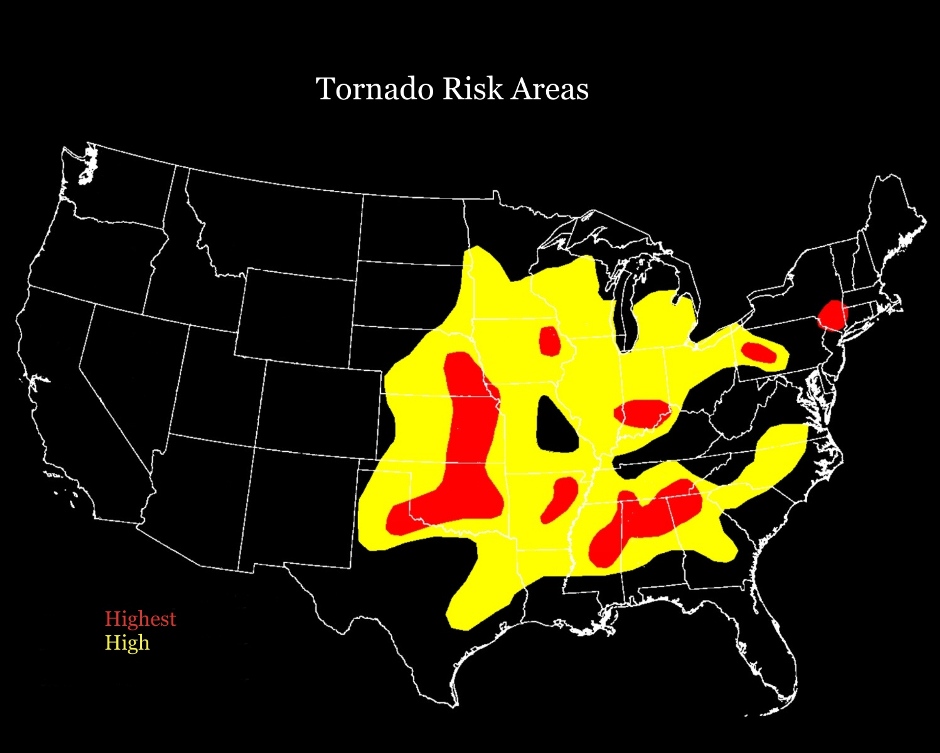I'm not afraid of storms, for I'm learning to sail my ship. - Aeschylus
Tornadoes are nature's most violent storms. A tornado appears as a rotating, funnel-shaped cloud that extends from a thunderstorm to the ground with whirling winds that can reach 300 miles per hour. Damage paths can be in excess of one mile wide and 50 miles long. Every state is at some risk from this hazard. Some tornadoes are clearly visible, while rain or nearby low-hanging clouds obscure others. Occasionally, tornadoes develop so rapidly that little, if any, advance warning is possible. Before a tornado hits, the wind may die down and the air may become very still. A cloud of debris can mark the location of a tornado even if a funnel is not visible. Tornadoes generally occur near the trailing edge of a thunderstorm. It is not uncommon to see clear, sunlit skies behind a tornado.
Tornado Facts
- The average tornado moves Southwest to Northeast, but tornadoes have been known to move in any direction.
- The average forward speed of a tornado is 30 mph, but may vary from stationary to 70 mph.
- Tornadoes are most frequently reported east of the Rocky Mountains during spring and summer months.
- Peak tornado season in the southern states is March through May; in the northern states, it is late spring through early summer.
- Tornadoes are most likely to occur between 3 pm and 9 pm, but can occur at any time.
Terminology
- Tornado Watch - Tornadoes are possible. Remain alert for approaching storms. Watch the sky and stay tuned to NOAA Weather Radio or commercial broadcast for information.
- Tornado Warning - A tornado has been sighted or indicated by weather radar. Take shelter immediately.
The Enhanced Fujita scale rates tornadoes by damage caused. An EF0 tornado, the weakest category, damages trees, but not substantial structures. An EF5 tornado, the strongest category, rips buildings off their foundations

Before a Tornado
- To begin preparing, you should build an emergency kit and make a family communications plan.
- Listen to NOAA Weather Radio or to commercial broadcasts for the latest information.
- Be alert to changing weather conditions. Look for approaching storms.
- Look for the following danger signs:
- Dark, often greenish sky
- Large hail
- A large, dark, low-lying cloud (particularly if rotating)
- Loud roar, similar to a freight train.
- If you see approaching storms or any of the danger signs, be prepared to take shelter immediately.
During a Tornado
- If you are in a structure:
- Go to a shelter area, basement, storm cellar, or the lowest building level. If there is no basement, go to the center of an interior room on the lowest level (closet, interior hallway) away from corners, windows, doors, and outside walls. Put as many walls as possible between you and the outside. Get under a sturdy table and use your arms to protect your head and neck.
- Do not open windows.
- If you are in a vehicle, trailer, or mobile home:
- Get out immediately and go to the lowest floor of a sturdy, nearby building or a storm shelter.
- If you are outside with no shelter:
- Lie flat in a nearby ditch or depression and cover your head with your hands.
- Do not get under an overpass or bridge. You are safer in a low, flat location.
- Never try to outrun a tornado in urban or congested areas in a car or truck.
After a Tornado
- Continue to monitor NOAA Weather Radio or to commercial broadcasts for the latest information.
- Use battery-powered lanterns, if possible, rather than candles to light homes without electrical power.
- Hang up displaced telephone receivers that may have been knocked off by the tornado.
- In general, if you suspect any damage to your home, shut off electrical power, natural gas and propane tanks to avoid fire, electrocution or explosions.
- If you smell gas or suspect a leak, turn off the main gas valve, open all windows and leave the house immediately. Notify the gas company, the police or fire departments and do not turn on the lights, light matches or do anything that could cause a spark.

